在之前的几篇security教程中,资源和所对应的权限都是在xml中进行配置的,也就在http标签中配置intercept-url,试想要是配置的对象不多,那还好,但是平常实际开发中都常常是非常多的资源和权限对应,而且写在配置文件里面写改起来还得该源码配置文件,这明显是不好的。因此接下来,将用数据库管理资源和权限的对应关系。数据库还是接着之前的,用mysql数据库,因此也不用另外引入额外的jar包。
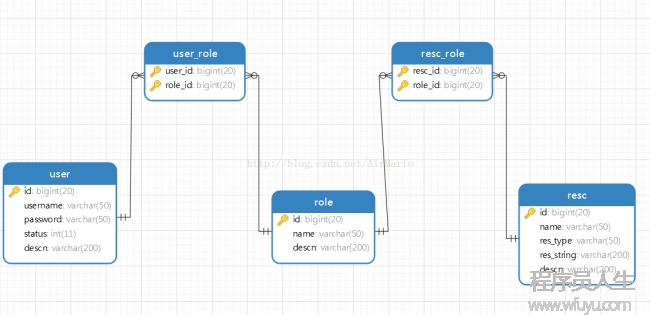
DROP TABLE IF EXISTS `resc`;
CREATE TABLE `resc` (
`id` bigint(20) NOT NULL DEFAULT '0',
`name` varchar(50) DEFAULT NULL,
`res_type` varchar(50) DEFAULT NULL,
`res_string` varchar(200) DEFAULT NULL,
`descn` varchar(200) DEFAULT NULL,
PRIMARY KEY (`id`)
) ENGINE=InnoDB DEFAULT CHARSET=utf8;
-- ----------------------------
-- Records of resc
-- ----------------------------
INSERT INTO `resc` VALUES ('1', '', 'URL', '/adminPage.jsp', '管理员页面');
INSERT INTO `resc` VALUES ('2', '', 'URL', '/index.jsp', '');
INSERT INTO `resc` VALUES ('3', null, 'URL', '/test.jsp', '测试页面');
-- ----------------------------
-- Table structure for resc_role
-- ----------------------------
DROP TABLE IF EXISTS `resc_role`;
CREATE TABLE `resc_role` (
`resc_id` bigint(20) NOT NULL DEFAULT '0',
`role_id` bigint(20) NOT NULL DEFAULT '0',
PRIMARY KEY (`resc_id`,`role_id`),
KEY `fk_resc_role_role` (`role_id`),
CONSTRAINT `fk_resc_role_role` FOREIGN KEY (`role_id`) REFERENCES `role` (`id`),
CONSTRAINT `fk_resc_role_resc` FOREIGN KEY (`resc_id`) REFERENCES `resc` (`id`)
) ENGINE=InnoDB DEFAULT CHARSET=utf8;
-- ----------------------------
-- Records of resc_role
-- ----------------------------
INSERT INTO `resc_role` VALUES ('1', '1');
INSERT INTO `resc_role` VALUES ('2', '1');
INSERT INTO `resc_role` VALUES ('2', '2');
INSERT INTO `resc_role` VALUES ('3', '3');
-- ----------------------------
-- Table structure for role
-- ----------------------------
DROP TABLE IF EXISTS `role`;
CREATE TABLE `role` (
`id` bigint(20) NOT NULL DEFAULT '0',
`name` varchar(50) DEFAULT NULL,
`descn` varchar(200) DEFAULT NULL,
PRIMARY KEY (`id`)
) ENGINE=InnoDB DEFAULT CHARSET=utf8;
-- ----------------------------
-- Records of role
-- ----------------------------
INSERT INTO `role` VALUES ('1', 'ROLE_ADMIN', '管理员角色');
INSERT INTO `role` VALUES ('2', 'ROLE_USER', '用户角色');
INSERT INTO `role` VALUES ('3', 'ROLE_TEST', '测试角色');
-- ----------------------------
-- Table structure for t_c3p0
-- ----------------------------
DROP TABLE IF EXISTS `t_c3p0`;
CREATE TABLE `t_c3p0` (
`a` char(1) DEFAULT NULL
) ENGINE=InnoDB DEFAULT CHARSET=utf8;
-- ----------------------------
-- Records of t_c3p0
-- ----------------------------
-- ----------------------------
-- Table structure for user
-- ----------------------------
DROP TABLE IF EXISTS `user`;
CREATE TABLE `user` (
`id` bigint(20) NOT NULL DEFAULT '0',
`username` varchar(50) DEFAULT NULL,
`password` varchar(50) DEFAULT NULL,
`status` int(11) DEFAULT NULL,
`descn` varchar(200) DEFAULT NULL,
PRIMARY KEY (`id`)
) ENGINE=InnoDB DEFAULT CHARSET=utf8;
-- ----------------------------
-- Records of user
-- ----------------------------
INSERT INTO `user` VALUES ('1', 'admin', 'admin', '1', '管理员');
INSERT INTO `user` VALUES ('2', 'user', 'user', '1', '用户');
INSERT INTO `user` VALUES ('3', 'test', 'test', '1', '测试');
-- ----------------------------
-- Table structure for user_role
-- ----------------------------
DROP TABLE IF EXISTS `user_role`;
CREATE TABLE `user_role` (
`user_id` bigint(20) NOT NULL DEFAULT '0',
`role_id` bigint(20) NOT NULL DEFAULT '0',
PRIMARY KEY (`user_id`,`role_id`),
KEY `fk_user_role_role` (`role_id`),
CONSTRAINT `fk_user_role_role` FOREIGN KEY (`role_id`) REFERENCES `role` (`id`),
CONSTRAINT `fk_user_role_user` FOREIGN KEY (`user_id`) REFERENCES `user` (`id`)
) ENGINE=InnoDB DEFAULT CHARSET=utf8;
-- ----------------------------
-- Records of user_role
-- ----------------------------
INSERT INTO `user_role` VALUES ('1', '1');
INSERT INTO `user_role` VALUES ('1', '2');
INSERT INTO `user_role` VALUES ('2', '2');
INSERT INTO `user_role` VALUES ('3', '3');user表中包括用户登陆信息,role角色表中包括授权信息,resc资源表中包括需要保护的资源。Spring Security需要的数据不过就是pattern和access类似键值对的数据,就像配置文件中写的那样:
<intercept-url pattern="/login.jsp" access="IS_AUTHENTICATED_ANONYMOUSLY" />1 <intercept-url pattern="/admin.jsp" access="ROLE_ADMIN" /> <intercept-url pattern="/**" access="ROLE_USER" />
其实当项目启动时,Spring Security所做的就是在系统初始化时,将以上XML中的信息转换为特定的数据格式,而框架中其他组件可以利用这些特定格式的数据,用于控制以后的验证操作。现在我们将这些信息存储在数据库中,因此就要想办法从数据库中查询这些数据,所以根据security数据的需要,只需要以下sql语句就能够:
select re.res_string,r.name from role r,resc re,resc_role rr where r.id=rr.role_id and re.id=rr.resc_id在数据中履行这条语句做测试,得到以下结果:
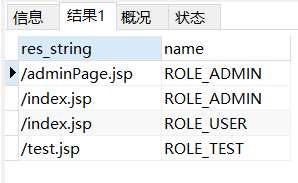
这样的格式正是security所需要的数据。
package com.zmc.demo; import java.sql.ResultSet; import java.sql.SQLException; import java.util.ArrayList; import java.util.Collection; import java.util.LinkedHashMap; import java.util.List; import javax.sql.DataSource; import org.springframework.jdbc.core.support.JdbcDaoSupport; import org.springframework.jdbc.object.MappingSqlQuery; import org.springframework.security.access.ConfigAttribute; import org.springframework.security.access.SecurityConfig; import org.springframework.security.web.access.intercept.DefaultFilterInvocationSecurityMetadataSource; import org.springframework.security.web.util.AntPathRequestMatcher; import org.springframework.security.web.util.RequestMatcher; /** * @classname JdbcRequestMapBulider * @author ZMC * @time 2017⑴⑴0 * 查询资源和角色,并构建RequestMap */ public class JdbcRequestMapBulider extends JdbcDaoSupport{ //查询资源和权限关系的sql语句 private String resourceQuery = ""; public String getResourceQuery() { return resourceQuery; } //查询资源 public List<Resource> findResources() { ResourceMapping resourceMapping = new ResourceMapping(getDataSource(), resourceQuery); return resourceMapping.execute(); } //拼接RequestMap public LinkedHashMap<RequestMatcher, Collection<ConfigAttribute>> buildRequestMap() { LinkedHashMap<RequestMatcher, Collection<ConfigAttribute>> requestMap = new LinkedHashMap<>(); List<Resource> resourceList = this.findResources(); for (Resource resource : resourceList) { RequestMatcher requestMatcher = this.getRequestMatcher(resource.getUrl()); List<ConfigAttribute> list = new ArrayList<ConfigAttribute>(); list.add(new SecurityConfig(resource.getRole())); requestMap.put(requestMatcher, list); } return requestMap; } //通过1个字符串地址构建1个AntPathRequestMatcher对象 protected RequestMatcher getRequestMatcher(String url) { return new AntPathRequestMatcher(url); } public void setResourceQuery(String resourceQuery) { this.resourceQuery = resourceQuery; } /** * @classname Resource * @author ZMC * @time 2017⑴⑴0 * 资源内部类 */ private class Resource { private String url;//资源访问的地址 private String role;//所需要的权限 public Resource(String url, String role) { this.url = url; this.role = role; } public String getUrl() { return url; } public String getRole() { return role; } } private class ResourceMapping extends MappingSqlQuery { protected ResourceMapping(DataSource dataSource, String resourceQuery) { super(dataSource, resourceQuery); compile(); } //对结果集进行封装处理 protected Object mapRow(ResultSet rs, int rownum) throws SQLException { String url = rs.getString(1); String role = rs.getString(2); Resource resource = new Resource(url, role); return resource; } } }说明:
resourceQuery是查询数据的sql语句,该属性在配置bean的时候传入便可。
内部创建了1个resource来封装数据。
getRequestMatcher方法就是用来创建RequestMatcher对象的
buildRequestMap方法用来最后拼接成LinkedHashMap<RequestMatcher, Collection<ConfigAttribute>>共security使用。
在将这部之前,先得了解大概下security的运行进程,security实现控制的功能其实就是通过1系列的拦截器来实现的,当用户登陆的时候,会被AuthenticationProcessingFilter拦截,调用AuthenticationManager的实现类,同时AuthenticationManager会调用ProviderManager来获得用户验证信息,其中不同的Provider调用的服务不同,由于这些信息可以是在数据库上,可以是在LDAP服务器上,可以是xml配置文件上等,这个例子中就是为数据库;如果验证通过后会将用户的权限信息放到spring的全局缓存SecurityContextHolder中,以备后面访问资源时使用。当访问资源,访问url时,会通过AbstractSecurityInterceptor拦截器拦截,其中会调用FilterInvocationSecurityMetadataSource的方法来获得被拦截url所需的全部权限,其中FilterInvocationSecurityMetadataSource的经常使用的实现类为DefaultFilterInvocationSecurityMetadataSource,这个类中有个很关键的东西就是requestMap,也就是我们上面所得到的数据,在调用授权管理器AccessDecisionManager,这个授权管理器会通过spring的全局缓存SecurityContextHolder获得用户的权限信息,还会获得被拦截的url和被拦截url所需的全部权限,然后根据所配的策略,如果权限足够,则返回,权限不够则报错并调用权限不足页面。
根据源码debug跟踪得出,其实资源权限关系就放在DefaultFilterInvocationSecurityMetadataSource的requestMap,中的,这个requestMap就是我们JdbcRequestMapBulider.buildRequestMap()方法所需要的数据类型,因此,顺气自然就想到了我们自定义1个类继承FilterInvocationSecurityMetadataSource接口,将数据查出的数据放到requestMap中去。制定类MyFilterInvocationSecurityMetadataSource继承FilterInvocationSecurityMetadataSource和InitializingBean接口。
package com.zmc.demo; import java.util.Collection; import java.util.HashSet; import java.util.List; import java.util.Map; import java.util.Set; import javax.servlet.http.HttpServletRequest; import org.springframework.beans.factory.InitializingBean; import org.springframework.security.access.ConfigAttribute; import org.springframework.security.web.FilterInvocation; import org.springframework.security.web.access.intercept.FilterInvocationSecurityMetadataSource; import org.springframework.security.web.util.RequestMatcher; /** * @classname MyFilterInvocationSecurityMetadataSource * @author ZMC * @time 2017⑴⑴0 */ public class MyFilterInvocationSecurityMetadataSource implements FilterInvocationSecurityMetadataSource, InitializingBean { private final static List<ConfigAttribute> NULL_CONFIG_ATTRIBUTE = null; // 资源权限集合 private Map<RequestMatcher, Collection<ConfigAttribute>> requestMap; //查找数据库权限和资源关系 private JdbcRequestMapBulider builder; /* * (non-Javadoc) * @see * org.springframework.security.access.SecurityMetadataSource#getAttributes * (java.lang.Object) * 更具访问资源的地址查找所需要的权限 */ @Override public Collection<ConfigAttribute> getAttributes(Object object) throws IllegalArgumentException { final HttpServletRequest request = ((FilterInvocation) object) .getRequest(); Collection<ConfigAttribute> attrs = NULL_CONFIG_ATTRIBUTE; for (Map.Entry<RequestMatcher, Collection<ConfigAttribute>> entry : requestMap .entrySet()) { if (entry.getKey().matches(request)) { attrs = entry.getValue(); break; } } return attrs; } /* * (non-Javadoc) * * @see org.springframework.security.access.SecurityMetadataSource# * getAllConfigAttributes() * 获得所有的权限 */ @Override public Collection<ConfigAttribute> getAllConfigAttributes() { Set<ConfigAttribute> allAttributes = new HashSet<ConfigAttribute>(); for (Map.Entry<RequestMatcher, Collection<ConfigAttribute>> entry : requestMap .entrySet()) { allAttributes.addAll(entry.getValue()); } System.out.println("总共有这些权限:"+allAttributes.toString()); return allAttributes; } /* * (non-Javadoc) * * @see * org.springframework.security.access.SecurityMetadataSource#supports(java * .lang.Class) */ @Override public boolean supports(Class<?> clazz) { return FilterInvocation.class.isAssignableFrom(clazz); } //绑定requestMap protected Map<RequestMatcher, Collection<ConfigAttribute>> bindRequestMap() { return builder.buildRequestMap(); } /* * (non-Javadoc) * * @see * org.springframework.beans.factory.InitializingBean#afterPropertiesSet() */ @Override public void afterPropertiesSet() throws Exception { this.requestMap = this.bindRequestMap(); } public void refreshResuorceMap() { this.requestMap = this.bindRequestMap(); } //get方法 public JdbcRequestMapBulider getBuilder() { return builder; } //set方法 public void setBuilder(JdbcRequestMapBulider builder) { this.builder = builder; } }说明:
requestMap这个属性就是用来寄存资源权限的集合
builder为JdbcRequestMapBulider类型,用来查找数据库权限和资源关系
其他的代码中都有详细的注释
<?xml version="1.0" encoding="UTF⑻"?>
<beans:beans xmlns="http://www.springframework.org/schema/security"
xmlns:beans="http://www.springframework.org/schema/beans" xmlns:xsi="http://www.w3.org/2001/XMLSchema-instance"
xsi:schemaLocation="http://www.springframework.org/schema/beans
http://www.springframework.org/schema/beans/spring-beans⑶.0.xsd
http://www.springframework.org/schema/context
http://www.springframework.org/schema/context/spring-context⑶.1.xsd
http://www.springframework.org/schema/tx
http://www.springframework.org/schema/tx/spring-tx⑶.0.xsd
http://www.springframework.org/schema/security
http://www.springframework.org/schema/security/spring-security.xsd">
<http pattern="/login.jsp" security="none"></http>
<http auto-config="false">
<form-login login-page="/login.jsp" default-target-url="/index.jsp"
authentication-failure-url="/login.jsp?error=true" />
<logout invalidate-session="true" logout-success-url="/login.jsp"
logout-url="/j_spring_security_logout" />
<!-- 通过配置custom-filter来增加过滤器,before="FILTER_SECURITY_INTERCEPTOR"表示在SpringSecurity默许的过滤器之前履行。 -->
<custom-filter ref="filterSecurityInterceptor" before="FILTER_SECURITY_INTERCEPTOR" />
</http>
<!-- 数据源 -->
<beans:bean id="dataSource" class="com.mchange.v2.c3p0.ComboPooledDataSource"
destroy-method="close">
<!-- 此为c3p0在spring中直接配置datasource c3p0是1个开源的JDBC连接池 -->
<beans:property name="driverClass" value="com.mysql.jdbc.Driver" />
<beans:property name="jdbcUrl"
value="jdbc:mysql://localhost:3306/springsecuritydemo?useUnicode=true&characterEncoding=UTF⑻" />
<beans:property name="user" value="root" />
<beans:property name="password" value="" />
<beans:property name="maxPoolSize" value="50"></beans:property>
<beans:property name="minPoolSize" value="10"></beans:property>
<beans:property name="initialPoolSize" value="10"></beans:property>
<beans:property name="maxIdleTime" value="25000"></beans:property>
<beans:property name="acquireIncrement" value="1"></beans:property>
<beans:property name="acquireRetryAttempts" value="30"></beans:property>
<beans:property name="acquireRetryDelay" value="1000"></beans:property>
<beans:property name="testConnectionOnCheckin" value="true"></beans:property>
<beans:property name="idleConnectionTestPeriod" value="18000"></beans:property>
<beans:property name="checkoutTimeout" value="5000"></beans:property>
<beans:property name="automaticTestTable" value="t_c3p0"></beans:property>
</beans:bean>
<beans:bean id="builder" class="com.zmc.demo.JdbcRequestMapBulider">
<beans:property name="dataSource" ref="dataSource" />
<beans:property name="resourceQuery"
value="select re.res_string,r.name from role r,resc re,resc_role rr where
r.id=rr.role_id and re.id=rr.resc_id" />
</beans:bean>
<!-- 认证过滤器 -->
<beans:bean id="filterSecurityInterceptor"
class="org.springframework.security.web.access.intercept.FilterSecurityInterceptor">
<!-- 用户具有的权限 -->
<beans:property name="accessDecisionManager" ref="accessDecisionManager" />
<!-- 用户是不是具有所要求资源的权限 -->
<beans:property name="authenticationManager" ref="authenticationManager" />
<!-- 资源与权限对应关系 -->
<beans:property name="securityMetadataSource" ref="securityMetadataSource" />
</beans:bean>
<!-- 授权管理器 -->
<beans:bean class="com.zmc.demo.MyAccessDecisionManager" id="accessDecisionManager">
</beans:bean>
<!--认证管理-->
<authentication-manager alias="authenticationManager">
<authentication-provider>
<jdbc-user-service data-source-ref="dataSource" id="usersService"
users-by-username-query="select username,password,status as enabled from user where username = ?"
authorities-by-username-query="select user.username,role.name from user,role,user_role
where user.id=user_role.user_id and
user_role.role_id=role.id and user.username=?" />
</authentication-provider>
</authentication-manager>
<!--自定义的切入点-->
<beans:bean id="securityMetadataSource"
class="com.zmc.demo.MyFilterInvocationSecurityMetadataSource">
<beans:property name="builder" ref="builder"></beans:property>
</beans:bean>
</beans:beans>
package com.zmc.demo; import java.util.Collection; import java.util.Iterator; import org.springframework.security.access.AccessDecisionManager; import org.springframework.security.access.AccessDeniedException; import org.springframework.security.access.ConfigAttribute; import org.springframework.security.authentication.InsufficientAuthenticationException; import org.springframework.security.core.Authentication; import org.springframework.security.core.GrantedAuthority; /** * @classname MyAccessDecisionManager * @author ZMC * @time 2017⑴⑴0 * */ public class MyAccessDecisionManager implements AccessDecisionManager { /* (non-Javadoc) * @see org.springframework.security.access.AccessDecisionManager#decide(org.springframework.security.core.Authentication, java.lang.Object, java.util.Collection) * 该方法决定该权限是不是有权限访问该资源,其实object就是1个资源的地址,authentication是当前用户的 * 对应权限,如果没登陆就为游客,登陆了就是该用户对应的权限 */ @Override public void decide(Authentication authentication, Object object, Collection<ConfigAttribute> configAttributes) throws AccessDeniedException, InsufficientAuthenticationException { if(configAttributes == null) { return; } //所要求的资源具有的权限(1个资源对多个权限) Iterator<ConfigAttribute> iterator = configAttributes.iterator(); while(iterator.hasNext()) { ConfigAttribute configAttribute = iterator.next(); //访问所要求资源所需要的权限 String needPermission = configAttribute.getAttribute(); System.out.println("访问"+object.toString()+"需要的权限是:" + needPermission); //用户所具有的权限authentication Collection<? extends GrantedAuthority> authorities = authentication.getAuthorities(); for(GrantedAuthority ga : authorities) { if(needPermission.equals(ga.getAuthority())) { return; } } } //没有权限 throw new AccessDeniedException(" 没有权限访问! "); } @Override public boolean supports(ConfigAttribute attribute) { // TODO Auto-generated method stub return true; } @Override public boolean supports(Class<?> clazz) { // TODO Auto-generated method stub return true; } }
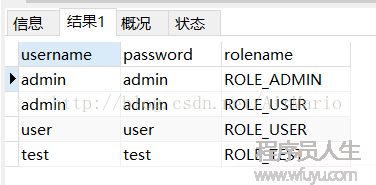
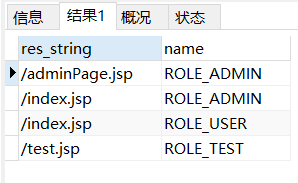
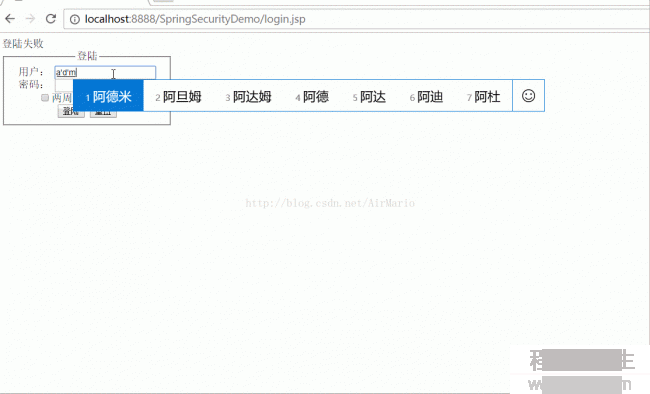
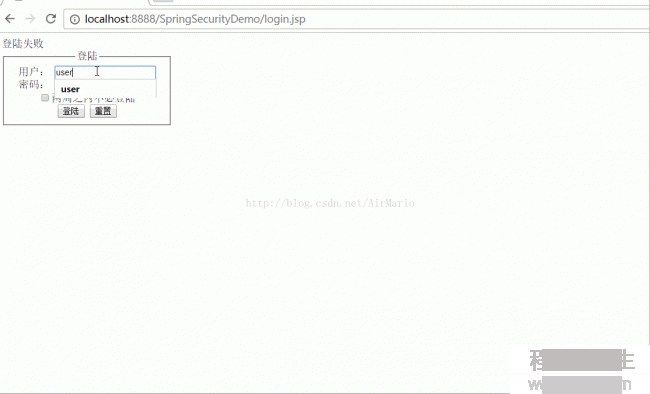
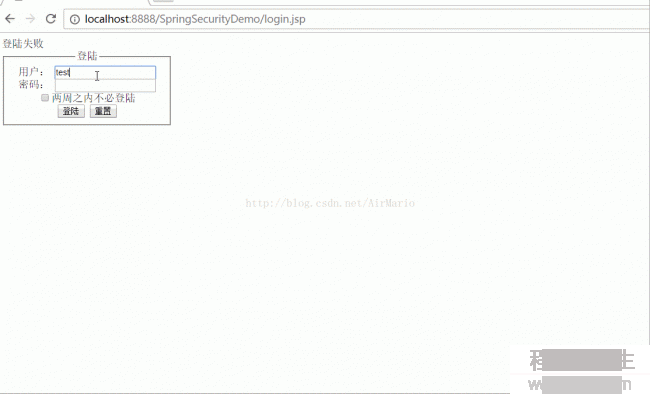

下一篇 JAVA多线程与并发学习总结